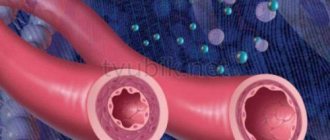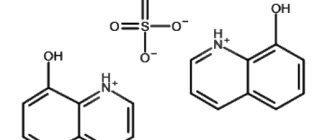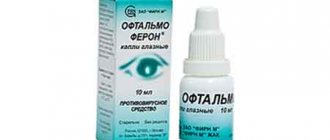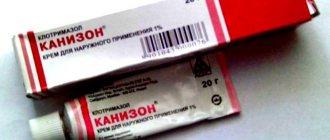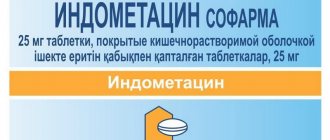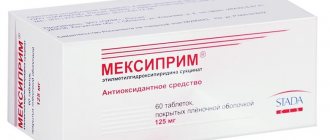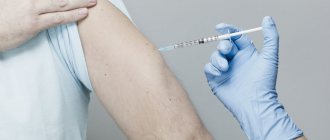- February 21, 2020
- Traumatology and surgery
- Evdokimova Irina
For musculoskeletal and neuralgic pain, doctors recommend using the local remedy “Finalgon”. The instructions for use state that this ointment has a pronounced analgesic effect. The drug does not fight the cause of pain, but quickly eliminates discomfort. This is a good remedy for symptomatic treatment, but it is very stinging. What types of pain syndrome does the ointment help with? And what should you do if a burning sensation appears after applying the composition? We will consider these questions in the article.
What does the drug consist of?
The ointment contains two active medicinal substances:
- Nonivamide. This is a synthetic compound that is similar in properties to capsaicin, an alkaloid from Spanish peppers. There are 5 mg of this substance per 1 g of ointment.
- Nicoboxil. This is a compound of nicotinic acid. 1 g of the drug contains 25 mg of this component.
In addition, additional ingredients are used in the ointment:
- Vaseline and Crodamol. A fatty ointment base that softens and moisturizes the skin.
- Citronella oil. A fragrance that gives the ointment a pleasant floral scent.
- Silica. Binds and removes toxic substances.
- Purified water. Used as a solvent.
- Sorbic acid. A preservative with antiseptic properties that helps preserve the ointment.
pharmachologic effect
Finalgon belongs to the group of local irritants used for joint and muscle pain.
The drug was developed and put into production 40 years ago by the pharmaceutical concern Boehringer Ingelheim Pharma GmbH and Co. International name of Finalgon ointment: Comb Drug. The pharmacological effect of the external drug is due to two active ingredients: nonivamide, nicoboxil.
The external agent is supplemented with auxiliary components in the form of silicon dioxide, petroleum jelly, and sorbic acid.
How the active components of the ointment work:
- Nonivamide. The component belongs to synthetic analogues of capsaicin, a plant alkaloid found in various types of Capsicum peppers. It is used for medical purposes as a local irritant and as a powerful pain blocker. Nonivamide gives a local feeling of warmth; acting on nerve endings, dulls pain; relieves discomfort by dilating blood vessels.
- Nicoboxil is a derivative of nicotinic acid. The main actions of the component: expands vascular walls, accelerates metabolic processes, the speed of enzymatic reactions.
What does this combination of main active ingredients that are included in the ointment give:
- increases the temperature of the skin at the site of pain projection;
- nicoboxil with nonivamide quickly penetrate into the subcutaneous layer;
- the maximum degree of expansion of vessels with capillaries is achieved;
- the therapeutic effect begins within a few minutes;
- the maximum therapeutic effect occurs in the first 30 minutes.
Release forms
"Finalgon" is available only in the form of an ointment, which is also called a cream or gel. The drug is not produced in other forms; it is intended exclusively for local treatment.
Finalgon ointment looks like a transparent or translucent creamy mass. It may be colorless or have a faint brownish tint. A high-quality product should not contain lumps or flakes.
The ointment is packaged in tubes of 20 or 50 g. Each package is equipped with an applicator. With its help, the medicine is applied to the skin.
Dosage and overdose
To apply to the skin, a 0.5 cm column of ointment is enough.
The external product is applied with an applicator to a clean and dry area of skin. For medicinal purposes, the area of application of Finalgon ointment should be approximately equal to the area of the patient's palm.
During the day, you can carry out 2-3 procedures of applying the ointment. The general course of treatment with the external agent Finalgon should not exceed 10 days.
Usually, when used correctly, overdoses with external agents are practically excluded. But Finalgon is a special drug that, if applied incorrectly and in excess of the recommended amount, can cause an overdose and local intoxication.
What are the symptoms of a drug overdose:
- local manifestations in the form of severe redness, swelling, with the formation of blisters and pustules;
- persistent burning sensation, feeling of “hot flashes”, soreness of the skin.
How does the drug work?
The active components of Finalgon cream (nonivamide and nicoboxil) dilate blood vessels. Moreover, each ingredient enhances the effect of the other. This provides the following therapeutic effect:
- pain reliever;
- distracting;
- anti-inflammatory.
Dilatation of blood vessels helps the ointment ingredients penetrate deep into the skin. Medicinal substances interact with special receptors and relieve pain in muscles and bones. This is accompanied by a feeling of warmth and burning, as well as redness of the skin.
When the blood vessels dilate, the muscles relax. This enhances the analgesic effect of the drug. This ointment is especially effective for pain caused by muscle spasms.
Increased blood flow leads to improved nutrition of cartilage. In some cases, the ointment helps restore tissue damaged due to injury or degenerative joint disease. This effect is especially pronounced if the drug is used in conjunction with chondroprotectors.
Gel "Finalgon" acts locally. An extremely small amount of its ingredients enters the bloodstream, so the drug has virtually no significant systemic effect.
How Finalgon works
You can understand what Finalgon does by reading the instructions for the drug. The annotation states that the effect of the drug is due to the components in its composition.
Nonivamide
Nonivamide is a synthetic analogue of capsaicin. This is a naturally occurring irritant - the active substance of Spanish pepper. Its main effects:
- It enhances the flow of calcium ions into the cell, causes its persistent depolarization and increases the sensitivity of skin receptors. So the receptors stop perceiving other signals. Nonivamide works as a distraction agent - it draws pain onto itself, removing it from other areas (for example, from muscles and joints).
- Blocks the functioning of neurons and reduces the content of P-substance in cells. This increases the sensitivity threshold of pain receptors. Previous unpleasant sensations are not perceived so acutely.
- Relieves pain. Nonivamide gradually penetrates the skin and underlying tissues. Its effect increases with repeated use. The drug also stimulates the body’s synthesis of its own analgesics – endorphins and enkephalins.
- Dilates blood vessels. The active substance of the drug increases blood flow in the affected area.
Nicoboxil
Nicoboxil is a derivative of nicotinic acid. It dilates blood vessels with the help of prostaglandins I2 and E2. After applying the drug, blood flow increases significantly and tissue nutrition improves.
Nicoboxil acts faster than nonivamide. It dilates blood vessels and causes a feeling of warmth almost immediately after application. Nicoboxil prepares the ground - creates optimal conditions for the penetration of nonivamide into pain receptors.
For what diseases is it used?
What does Finalgon ointment help with? First of all, this remedy is used as a local analgesic for diseases accompanied by pain in bones and muscles:
- joint inflammation;
- rheumatic diseases;
- neuralgia;
- Do not lie;
- lumbago (lumbar pain);
- inflammation of the joint capsule or synovium;
- sciatica;
- radiculitis;
- limb injuries;
- peripheral circulatory disorders.
The drug also helps with muscle pain that occurs after heavy physical work or hypothermia. It is also used for bruises to relieve pain.
We have listed only some of the diseases for which Finalgon ointment is used. What else is this remedy used for? Quite often, neurologists prescribe this medicine for osteochondrosis and arthrosis, especially during exacerbations. In this case, it is combined with chondroprotectors, anti-inflammatory ointments and vitamins.
Osteochondrosis of the cervical spine is not included in the list of indications for the use of Finalgon. This ointment is hot and should not be applied to the delicate skin of the neck. Using the product on such areas of the body may cause irritation of the epidermis.
Dosage
It is important to know how to use the product correctly. The ointment is used only externally
Before treating large areas of skin, it is important to conduct a sensitivity test. To do this, a small portion of the product is applied to the skin. If after half an hour no redness, swelling or other symptoms of an individual intolerance reaction appear, Finalgon can be used in the area of the inflammatory process.
It is recommended to apply a 0.5 cm column of ointment to the skin, thoroughly rubbing the product using the applicator. You should not rub Finalgon intensively. The product is applied 2-3 times a day, and the time intervals between applications should be approximately equal. If Finalgon is used to prepare muscles for loads, it must be applied 30 minutes before training. If after using the product the pain does not calm down, you should consult a doctor. He will help you choose more effective analogues, for example, Betalgon or Betanicomylon.
Non-traditional application
Doctors allow the use of this drug in some cases not covered by the official instructions. After all, the ingredients that make up this product not only relieve pain. They also have additional medicinal properties.
Some athletes apply Finalgon ointment to their limbs before training and competitions. What is this remedy used for during physical activity? The drug causes blood flow to the muscles and helps to “warm up” them. It prepares the musculoskeletal system for stress and reduces the risk of injury.
Sometimes women use Finalgon ointment for cosmetic purposes. What does this drug help with? It can be used to combat cellulite. This product increases blood flow and irritates the skin. Swelling appears at the site of its application. This allows you to smooth out the skin and eliminate the “orange peel”.
Benefits of Finalgon ointment
The drug has advantages over other similar drugs:
- High efficiency. The combined drug Finalgon relieves pain better due to its composition. Two irritating and vasodilating components act against inflammation at once. They complement each other: nicoboxil helps nonivamide penetrate the tissue. When used together, these substances work faster and more efficiently. Thermal effects dilate blood vessels, increase blood flow, accelerate the flow of oxygen into tissues and trigger regeneration.
- Favorable systemic influence. Finalgon increases the number of leukocytes in peripheral blood, activates phagocytosis and increases the production of protective antibodies. It helps the body fight infection and inflammation.
- Economical application. Finalgon relieves pain when used in small doses.
- Quick effect. Finalgon ointment begins to work within a few minutes and reaches its maximum after half an hour.
Contraindications
Instructions for use of Finalgon ointment categorically prohibit the use of the drug for the treatment of children under 12 years of age. This remedy can only be used for the treatment of adolescents and adults.
When treating children over 12 years of age, it is necessary to carefully monitor the patient’s psycho-emotional state. If it is difficult for a teenager to tolerate the burning sensation that occurs, then it is better to avoid using the ointment.
Absolute contraindications include an allergy to any ingredient of the drug. The ointment can only be applied to healthy skin. If the patient has wounds, abrasions or inflammation of the epidermis, then this remedy should not be used.
The instructions for use of the Finalgon gel contain a warning that the effect of the ointment on the body of pregnant patients has not been studied. It is also unknown whether the components of the drug pass into breast milk. Therefore, during pregnancy and lactation, women should refrain from applying the ointment.
On sensitive areas of the skin, this product should be used very carefully and in small quantities. It is not advisable to apply the ointment to the neck, inner thighs and lower abdomen.
Composition of the medicine
The effectiveness of the drug is due to the presence of two active active ingredients in the Finalgon ointment: nonivamide and nicoboxil. These components act on the body according to the same principle, mutually potentiating each other’s effect. Each gram of Finalgon ointment contains 4 milligrams of nonivamide and 25 milligrams of nicoboxil.
In addition to this combination, the drug contains a special complex of auxiliary components that help achieve optimal consistency (crodamol, petroleum jelly, sorbic acid, citronella oil, deionized water).
Negative effects
The instructions for Finalgon ointment indicate the possible occurrence of side effects. Most often there are signs of skin irritation or allergic reactions. The following undesirable manifestations are possible:
- a feeling of severe burning at the site of application of the ointment;
- formation of pustules and blisters on the skin;
- contact dermatitis;
- severe itching;
- red rash;
- cough;
- difficulty breathing;
- swelling of the face;
- feeling of numbness or "crawling" sensation.
In severe cases, allergy sufferers may experience anaphylactic shock. Therefore, before use, the ointment should be tested on a small area of skin.
Many patients experience a burning sensation at the site of application of Finalgon. The instructions for use prohibit the use of excessive amounts of ointment, as this can lead to burns. An overdose is accompanied by redness of the skin, the appearance of a blistering rash, pain and burning. Sometimes systemic effects appear: redness of the upper body, feeling of heat, decreased blood pressure.
In such cases, you need to remove excess ointment using a thick cream or oil. Do not wash off the drug with water or alcohol solutions, this will enhance the absorption of burning components. Further treatment of the burn is carried out with symptomatic means.
Does Finalgon have side effects?
Some patients develop the following side effects after using Finalgon ointment:
- cough and shortness of breath;
- skin burn (in case of individual intolerance to the drug and exceeding its dosage);
- intense burning sensation in the area where the drug was applied;
- decreased skin sensitivity in the treated area;
- the appearance of skin rashes;
- allergy. The main symptoms of a local allergic reaction are rash, itching, urticaria, and swelling.
If you notice any adverse reactions, you should immediately wash off the ointment. Naturally, you should not continue using Finalgon in this case. However, you should not be afraid: reviews say that the product extremely rarely causes significant adverse reactions.
An excessive amount of finalgon can cause severe itching and redness on the patient’s skin
If the ointment gets into your eyes, nose or mouth
Getting the ointment into the eyes, nasal passages or mouth does not lead to dangerous consequences, but is accompanied by an unpleasant burning sensation. In this case, it is necessary to urgently remove the composition from the mucous membranes.
If the composition gets on the conjunctiva, then you need to squeeze a small amount of Vaseline into the eye. Then the oil product is removed with a cloth or napkin.
If the ointment gets into your nose, you need to rinse your nostrils with a liquid oil composition. After this, you should not shower or bathe for several hours.
Penetration of the ointment into the oral cavity causes an unpleasant burning sensation. In rare cases, this can lead to stomatitis. You should immediately hold a small amount of vegetable oil in your mouth and then spit it out. This procedure is repeated until the burning sensation and unpleasant taste disappear.
It is strictly forbidden to wash or rinse the affected area with water, alcohol or vodka. This will lead to a sharp increase in pain and burning.
Terms of use
The instructions for the Finalgon gel recommend that you conduct a test before using the drug. A drop of ointment should be applied to a small area of the epidermis and monitor the reaction. If after 10–15 minutes no redness, severe burning or allergy appears, then the drug can be used for treatment.
The composition should be applied using a special applicator, which is included with the tube. The dosage of the drug is determined by the doctor. The maximum allowable amount is 5 mm of ointment, squeezed out of a tube, onto an area of skin the size of the palm of your hand. The product should be rubbed in with massaging movements. The medicine can be applied up to 3 times a day. The warming effect of the drug is felt instantly, and the analgesic effect develops after 2–3 hours.
If there is no improvement 10–12 days after starting treatment, you should visit a doctor. It is possible that the ointment needs to be replaced with another product.
After using the warming ointment, you should not take a bath or shower for several hours. You should not wrap the area where Finalgon is applied with a warm cloth. The instructions warn that this may cause severe burning.
After using the ointment, you should wash your hands well. For sensitive skin, apply the composition while wearing protective gloves. Avoid contact of the composition with mucous membranes and eyes. This causes pain and burning.
This remedy can be used for bruises if there is no hematoma on the affected area. Otherwise, the ointment may increase hemorrhage, as it dilates the blood vessels. The composition is applied in small quantities once a day for 5–10 days.
It should be remembered that if the drug is used for a long time on the same part of the body, addiction may occur. The therapeutic effect gradually decreases. In this case, the dosage of the cream can be increased after consulting a doctor.
Finalgon contraindications and side effects
The ointment should not be used to treat the following diseases and pathological conditions:
- hypersensitivity to the components of the drug;
- open wound surfaces;
- areas of the body with delicate skin: lower abdomen, inner thighs, neck area.
The use of ointment for the treatment of children under 12 years of age is not recommended.
The medicine should not be used after a hot bath, since Finalgon can increase vasodilatation and provoke the development of side effects:
As a result of prolonged use of the drug or unauthorized increase in dosage, patients may experience the development of side effects of the drug, which is expressed by symptoms such as a strong burning sensation, shortness of breath, coughing attacks, and impaired skin sensitivity.
Some patients may develop an allergic reaction, which is accompanied by urticaria, itching, swelling of the skin in the face and neck, and the appearance of vesicles.
In more severe cases, a decrease in blood pressure and the development of Quincke's edema may occur.
If such signs occur, you should stop using the ointment and seek qualified medical help.
The development of side effects of the drug depends on the individual characteristics of the patient’s body and his age. In some cases, the development of negative symptoms occurs within a few minutes, and sometimes on the second day after using the ointment.
Special applications
If the ointment is used to warm up the muscles before training or sports competitions, then it should be applied half an hour before physical activity. Children over 12 years of age can also use the drug before sports, if the drug is well tolerated and does not cause a strong burning sensation.
If the drug is used to combat cellulite, it should be applied after a shower. There are two options for using ointment for cosmetic purposes:
- A small amount of ointment (the size of a pea) is added to a regular cream and applied to problem areas of the body.
- Areas of cellulite are treated with regular cream, and a warming ointment is applied on top.
To achieve the desired effect, the procedure must be repeated twice a week. Doctors and cosmetologists believe that using a warming ointment alone is not enough to combat cellulite. You need to pay attention to your diet and lifestyle, use special anti-cellulite creams and do massage treatments.
Additionally
When purchasing Finalgon, you should pay attention to the expiration date, and the low price should alert you, indicating a fake. On average, the price ranges from 184 – 300 rubles.
Analogues of Finalgon:
- Alvipsal;
- Vipralgon;
- Boromenthol;
- Viprosal and Viprosal B;
- Viprapine;
- Viprosal-Farkos;
- Viprosal-Nizhpharm;
- Camphor;
- Gavkamen;
- Kolkhuri;
- Capsicam;
- Nayatoks;
- Kuznetsova;
- Salvisar;
- Nizhvisal and Nizhvisal V;
- Ungapiven;
- Traumeel S;
- Eftimethacin;
- Espol;
- Nicoflex.
Storage and price
In order for the ointment to retain its medicinal qualities for a long time, you need to properly store the tube of Finalgon. The instructions for use recommend protecting the packaging with the drug from exposure to sunlight and moisture. Permissible storage temperature is not higher than +25 °C. Under such conditions, the ointment remains shelf life for 4 years.
The ointment can be purchased without a prescription, but is not recommended for use without consulting a doctor. The drug has pronounced burning properties, and only a doctor can assess the possible skin reaction to this drug. The price of the ointment in pharmacy chains is from 350 to 550 rubles.
Use during pregnancy and lactation
The drug should not be taken during pregnancy and breastfeeding, since there is no information about the effect of the drug on the fetus and baby.
Finalgon should not be used during pregnancy and breastfeeding, as there is no data on the safety of its use in pregnant and lactating women.
Special studies on the effect of Finalgon on the fertility of women and men have not been conducted.
Analogs
There is no complete structural analogue of the ointment. However, you can choose products with a similar effect:
- Non-steroidal anti-inflammatory ointments: Voltaren, Diclofenac, Ketoprofen. These local remedies also relieve pain and inflammation. They practically do not irritate the skin, but have a large number of side effects, including systemic ones.
- Locally irritating ointments: “Apizartron”, “Capsicam”, “Viprosal”. These drugs have a similar mechanism of pain relief, but contain different active ingredients. They can also cause a burning sensation when applied to a sore area.
Before replacing the drug with an analogue, you should consult your doctor. It should be remembered that Finalgon is a warming ointment. It cannot always be replaced with cooling pain-relieving gels.
Patients often replace Finalgon with Fastum Gel. But these remedies cannot be considered analogues; they are intended to treat injuries of various types. "Fastum gel" has a cooling effect and is used for fresh bruises with hematomas. Finalgon causes a rush of warmth to the skin. It does not help resolve bruises. This ointment is best used for either old injuries or bruises without hemorrhages.
Finalgon in the fight against pain
F
inalgon is a topical agent that is a combination of two vasodilators: nonivamide, a synthetic analogue of capsaicin, and nicoboxil, a derivative of nicotinic acid.
The drug belongs to the group of skin irritants
that cause:
1. Local effects: hyperemia, swelling, irritation of sensory receptors (pain, burning)
2. Reflex effects:
• axon-reflexes
• reflex irritation of the respiratory and vasomotor centers from any area of the skin, especially from the skin of the face
• stimulation of the hypothalamus-pituitary-adrenal system, increased release of adrenocorticotropic hormone, glucocorticoids
3. Humoral effects: entry into the bloodstream of breakdown products of tissue proteins, histamine and other mediators.
The distracting effect of the drug is based on irritation of areas of the body surface, which is accompanied by a change in the functional state of certain organs. In addition, the influence of irritating substances is carried out on the corresponding organs through trophic reflexes - nervous influences on metabolism in tissues. The mechanism of the “distracting” action is very complex and has not been fully elucidated. However, it is known that all reflexes from skin receptors, including trophic ones, the so-called cutaneous-visceral ones, are directed mainly to internal organs that receive innervation from the same segment of the spinal cord. For this reason, it is necessary to rationally select the site of application of the irritating agent. The action of Finalgon differs from the mechanism of action of non-steroidal anti-inflammatory drugs that suppress cyclooxygenase and prostaglandin synthesis. The reduction of soft tissue tenderness achieved by using irritants is based on the principles described and is widely used in rheumatology and sports medicine. Irritants have an analgesic effect and increase blood supply to the muscle. Improved blood supply leads to muscle relaxation and increased cellular regeneration. This leads to relief of chronic pain due to degenerative and inflammatory lesions of the musculoskeletal system. Pain associated with muscle strain or injury is also reduced.
The mechanism of action of Finalgon is associated with the influence of its components on receptor complexes involved in the formation and perception of pain
. The natural substance capsaicin and its synthetic analogue, nonivamide, are acid derivatives of homovanillin, slightly different in the structure of the alkyl chain. Their pharmacological action is identical.
Painful stimuli act on nerve endings, which are represented by C-fibers, which have a 3-10 layer structure and a thickness of about 2 microns. 90% of pain receptors respond to thermal, mechanical and chemical stimuli. Being actually pain sensors, C-fibers carry the pain signal to the spinal cord, and then through ascending pathways it is sent to the brain, where pain suppression centers can affect the degree of pain. Understanding the fundamental cellular and molecular mechanisms of action of irritants has been made possible by the discovery of a potent capsaicin analog, resiniferatoxin, isolated from Euphorbia resinifera and the synthesized capsaicin antagonist, ofcapsazepine. When receptors are excited by capsaicin or its analog nonivamide, nonselective cation channels open, permeability to sodium and calcium ions increases, which leads to depolarization of the neuron membrane and the release of neuropeptides. In addition, stimulation of skin pain receptors of both C-fibers and thin myelin fibers, persistent depolarization of the membrane lead to depletion of neurotransmitters, in particular norepinephrine, and complete blockade of pain stimuli, which is perceived as analgesia [1,2].
Nicoboxil enhances the effect of nonivamide and causes direct expansion of capillaries, improving microcirculation. Therefore, the use of Finalgon is accompanied by redness, a feeling of warmth and the elimination of pain.
.
Finalgon compares favorably with other locally irritating drugs. It activates metabolism, ensures dilation of blood vessels, hyperemia, increased blood flow, increased extensibility of connective tissue and muscles while decreasing muscle tone.
Unlike Finalgon, drugs containing menthol cause a feeling of cold, combined with minor pain relief. With prolonged use of menovazine, dizziness, general weakness, and decreased blood pressure are possible. Preparations based on bee and snake venom often cause allergic reactions and have many contraindications (for example, acute infectious diseases, tuberculosis, hepatitis, diabetes mellitus, organic diseases of the central nervous system, pregnancy, etc.). Finalgon is usually well tolerated
. In rare cases, allergic skin reactions may occur. It is also not applied to wounds and areas of skin with impaired permeability, to the neck, inner thighs and abdomen.
Finalgon is used for pain in muscles and joints, injuries to muscles and ligaments, inflammation of the joints and peripheral circulation disorders.
. It is highly effective for radiculitis, arthritis, and neuralgia. Finalgon ointment acts as an effective irritant and as a thermal patch.
For a palm-sized area of skin, it is recommended to squeeze out a column of the drug just 0.5 cm long from a tube (the tube contains a total of 180 doses of the drug, which allows for several courses of therapy). The drug is rubbed into the affected part of the body and surrounding tissue with light massaging movements.
Assessment of the effects of irritants was previously based solely on subjective methods. The degree of pain and dysfunction was usually assessed by patients, and objective recording of effects presented significant difficulties. The effectiveness of Finalgon was assessed using modern examination methods, including the laser method using Doppler equipment. Previously obtained information about the effectiveness of the ointment and its constituent substances was confirmed. When assessing the degree and rate of development of the hyperemia reaction, differences were identified in the onset and duration of action of nicoboxil and nonivamide. When used in combination in Finalgon ointment, the medicinal substances potentiated each other's effects. Hyperemia and analgesia developed almost immediately after applying the ointment and lasted for several hours, which clearly exceeded the results of using individual substances.
Josenhans [3] used Finalgon ointment in 60 patients with shoulder pain due to osteochondrosis of the cervical spine, which is often accompanied by impaired peripheral blood flow. He recorded an increase in skin temperature of 5°C at the site of application of the ointment and by 3.5°C on the skin of the index finger compared to the use of placebo ointment, which caused an increase in temperature of only 0.2°C.
The use of Finalgon was studied in 1791 patients with rheumatic diseases, neuralgia, soft tissue bruises, and peripheral circulatory disorders. In the observations of Brill [4], Haase and Haslreiter [5], Furtenbach [6], Geyer [7], Lemke [8] and Chitil and Ortner [9], all patients noted a feeling of warmth that arose after a short period of time and continued until 6 o'clock. The feeling of warmth was accompanied by a decrease in pain and easing of muscle tension. When first applied, the feeling of warmth was perceived by some patients as a burning sensation, which lost intensity with subsequent applications of the ointment. In addition, it was noted that the feeling of warmth arose again under the influence of external factors (bed, bath) and during exercise.
Benz [10] reported on 1234 patients in whom the use of Finalgon led to a satisfactory reduction in muscle tension and pain, with the majority of patients reporting the disappearance of pain.
More recent clinical data also confirm the high effectiveness of capsaicin in patients with osteoarthritis of the knees, hips and rheumatoid arthritis
[11,12].
The effect of Finalgon on sports injuries was studied by Hainbock [13]. In 70 cases of muscle bruises and sprains or joint injuries, he found an immediate decrease in muscle stiffness, pain relief, rapid resolution of effusions and swelling, and rapid restoration of tissue damage. An earlier start to training with active movements became possible for 50 student athletes (30 men and 20 women) and 121 professional athletes. Kochner [14] studied the preventive effect of Finalgon, prescribing the ointment in two ways - applying it daily in the morning before starting a workout or in the evening - to skin areas along the projection of painful muscles. The ointment was applied to large surfaces of the skin of the upper extremities, shoulder girdle and lower extremities. At the same time, no undesirable skin reactions, disorders of microcirculation, breathing or digestion were observed. Despite intense training, none of the athletes experienced muscle strain, and no tendon or ligament damage was noted.
In 56 athletes, Aicher et al used Finalgon for therapeutic purposes for sports injuries: muscle strain, hematomas, sprains, dislocations and bone fractures. In all cases, they observed an improvement in the condition: resolution of hematomas, disappearance of edema, increased muscle elasticity
[15].
In local irritant therapy, a combination of drugs acting on capsaicin-sensitive receptors (nicoboxil) with a vasodilator derived from nicotinic acid can be even more widely used. Information obtained in recent years about the preventive and therapeutic effects of Finalgon opens up new possibilities for the treatment of diseases accompanied by pain and trophic disorders.
The list of references can be found on the website https://www.rmj.ru
Combined preparation for external use –
Finalgon (trade name)
(Boehringer Ingelheim)
References:
1. Szolcsany J. (1991): Perspektive of Capsaicin-type Agents in Pain Therapy and Research. Kluwer Academic Publishers Winston C. B. Parris.
2. Maggi CA The pharmacology of the efferent function of sensory nerves. J. Auton. Pharmac.(1991) 11,173–208.
3. Josenhans G. (1954): Skin segment and peripheral blood circulation in rheumatic illnesses. Dtsch. med. Wschr. 79:505–507.
4. Brill F. (1952): Clinical Report on Final Point. Pro. Med. (Munisch), 21: 429–431.
5. Haase W. & E. Haslreiter (1953): Percutaneous heat-sensitising therapy. Arztl. Praxis 5:2.
6. Furtenbach W. (1954): Experience with Final point in the treatment of rheumatic illnesses. Vienna. med. Wschr. 104:853–854.
7. Geyer F., M.Neumayer & K.Schmidt (1956): Percutaneous heat-sensitising therapy with Final ointment. Vienna. med.Wschr.106:233–234.
8. Lemke W. (1957): Experience with hyperaemizing measures in non-rheumatic indications. Landarzt 33:1055–1057.
9. Chitil W. & H. Ortner (1959): Clinical experience with Final point in a total of 26 cases. Prakt. Arzt (Vienna) 13: 201–207.
10. Benz R. (1959): On the treatment of vertebragene pain symptoms with Finalgon ointment and liniment. Med. 48:2355–2358.
11. Deal C.; Schnitzer TJ; Lipstein E.; Seibold JR; Stevens RM; Levy MD; AlbertD. & Renold F. (1991): Treatment of Arthritis with Topical Capsaicin: A Double–blind Trial. Clin. Ther. 13: 383–395.
12. McCarhy GM & McCarthy DJ (1992): Effect of Topical Capsaicin in the Therapy of Painful Osteoarthritis of the Hands. J. Rheumatol. 19; 604–607.
13. Hainbock W. (1955): Experience with Final point in sports injuries. Vienna. med.Wsch. 105: 147–148.
14. Kochner G. (1955): Prevention and therapy of frequent sports injuries with hyperaemic substances. Sportmed.6: 42–44/56–57.
15. Aicher B, Dr.M. Stucker and Prof. Dr. P. Altmeyer. Medication for Skin–sensitising Therapy. Pharmacists Journal. Vol.11/96. 18th.Year. Pages 44–50.
Experts' opinion
Orthopedists, neurologists and rheumatologists often use this drug in their practice. Doctors believe that this remedy has a good “distracting” effect and quickly relieves even severe pain.
At the same time, experts warn that in case of serious diseases of the musculoskeletal system, the ointment cannot be used as the only treatment. It only relieves pain, but has little effect on the causes of pathology. For treatment to be complete and effective, this drug must be combined with other medications.
pharmachologic effect
Finalgon ointment has an anti-inflammatory, analgesic, warming and vasodilating effect on the painful area. It should be used topically for additional therapy for dystrophic or inflammatory diseases of the musculoskeletal system. When applying the drug, metabolism is normalized and blood circulation is restored.
Nonivamide, as one of the analogues of capsaicin, has strong analgesic properties. They manifest themselves as a result of penetration of the active component into peripheral nociceptive C-fibers and A-delta nerve endings. When the gel is repeatedly applied to the skin, the medicinal effect intensifies. Nonivamide also helps dilate blood vessels. The patient experiences a feeling of warmth at the application site. This occurs because afferent nerve endings in the epidermis are stimulated.
Another active substance is nicoboxil, which is a drug from the same pharmacological group as nicotinic acid. This drug also has the ability to dilate blood vessels. Prostaglandins I2 and E2 are involved in the process. It has a hyperemic effect on the painful area, far superior to the active effect of nonivamide.
In addition, both active components are substances that complement each other. Due to this interaction, the speed of enzymatic reactions becomes much greater and the metabolism of subcutaneous tissue begins to activate. This is manifested by an increase in skin temperature and the appearance of hyperemia. The effect lasts only a few minutes, and after about half an hour the patient will feel relief. At this time, the maximum concentration of the drug in the blood is determined.
Before the release of the drug, special studies were carried out. After which it was proven that the best combination is the percentage ratio: 2.5% nicoboxil and 0.4% nonivamide. The experiment involved patients who complained of acute nonspecific pain in the lower back. After using Finalgon ointment, they felt a decrease in pain intensity 4 hours after the first use (the drug was applied three times a day, the duration of the study was 4 days). All subjects confirmed that the pain syndrome began to disappear after 30-60 minutes.
There are no data on pharmacokinetics, or the removal of active substances from the body.
Positive reviews
Most people respond positively to the ointment. Typically, this remedy is used for severe muscle and bone pain, which is accompanied by limited mobility of body parts. Almost all patients note a significant improvement in their condition after using the ointment.
Many are confident that their pain has completely disappeared after a course of treatment with ointment. Some people report that the drug helped partially reduce pain and restore movement. But almost all patients believe that this old, proven remedy has a pronounced therapeutic effect.
You can find positive reviews from women about using anti-cellulite ointment. If you apply this product regularly, then after 10-12 procedures you will notice a reduction in the “orange peel” and smoothing of the skin.
Negative reviews
You can also find negative reviews about the ointment. Some patients report that they experienced a strong unbearable burning sensation after applying the composition. This forced them to stop using the drug.
This may be due either to an overdose of the drug, or to individual characteristics of perception. People with a low pain threshold have difficulty withstanding the burning sensation, so the effects of locally irritating ointments seem unbearable to them. But at the same time, patients do not deny the pain-relieving effect of the drug.
Pharmacodynamics and pharmacokinetics
Pharmacodynamics
The ointment contains two drugs: nonivamide, a capsaicin derivative isolated from pepper and having a local irritant effect, and nicoboxil, which has a pronounced vasodilating effect. The mechanism of action is associated with stimulation of visceral skin receptors and increased local blood circulation, which leads to analgesic, warming and antispasmodic effects.
The complex action of the two substances eliminates muscle pain and improves joint mobility. The action manifests itself locally. The appearance of redness immediately after applying the ointment indicates penetration of the components into the skin. The maximum effect is observed after 30 minutes.
Pharmacokinetics
https://www.youtube.com/watch?v=ytpolicyandsafetyru
Not studied.
